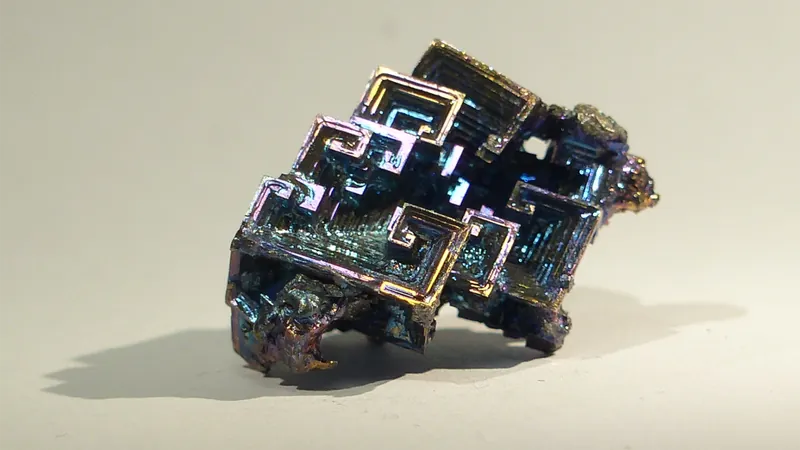
Breaking Boundaries: New Discoveries in Cosmic Collisions Unveiled!
2025-09-01
Author: Mei
A Cosmic Leap Forward
In an astonishing breakthrough for gravitational-wave astronomy, an international consortium of researchers has unveiled a staggering 128 new events of cosmic collisions, including magnificent encounters between black holes and neutron stars.
This groundbreaking discovery effectively more than doubles our tally of known gravitational-wave events, representing a pivotal moment in our quest to understand the vast Universe.
The Power of Collaboration
The revelations stem from the latest data release by a global collaboration of gravitational-wave observatories, notably the Laser Interferometer Gravitational-Wave Observatory (LIGO), the Virgo Gravitational Wave Interferometer, and the Kamioka Gravitational Wave Detector (KAGRA).
The newly released Gravitational Wave Transient Catalog (GWTC-4.0) details findings from the first nine-month observing run conducted between May 2023 and January 2024.
The Nature of Gravitational Waves
Since their first detection in 2015, gravitational waves have captivated scientists as they represent ripples in the very fabric of space-time, produced by titanic cosmic collisions.
UK scientists have been at the forefront of this research, pioneering the technology and analytical methods to discern these subtle signals from the vast cosmic noise.
UK’s Vital Role in Cosmic Research
With robust support from the Science and Technology Facilities Council, several UK institutions, including the University of Glasgow and the University of Portsmouth, have made significant contributions towards the advancement of gravitational-wave science.
They have developed ultra-sensitive detectors for LIGO observatories and led critical analyses of the complex data they generate.
Enhanced Sensitivity, Greater Discoveries
Recent upgrades to these detectors have boosted their sensitivity by 25%, expanding our observational capacity and enabling the detection of more distant and massive black hole mergers.
Unveiling Cosmic Mysteries
Dr. Daniel Williams, a leading researcher from the University of Glasgow, emphasized that this new update showcases the extraordinary capabilities of the international gravitational-wave network and the advanced analysis techniques that allow us to extract faint signals from the data.
Among the 128 new events is GW230814, the loudest signal ever captured, shedding light on black holes that emerged from previous mergers and offering insights into star evolution in dense cosmic environments.
Exploring Einstein’s Legacy
The upgraded detectors not only increase the number of observable events but also enhance the precision of our measurements. This allows researchers to test the fundamental tenets of Einstein's theory of gravity with greater accuracy.
Each detected merger provides crucial data pertaining to the expansion rate of the Universe, aiding efforts to refine the measurement of the elusive Hubble constant.
A New Dawn in Cosmology
Tessa Baker from the University of Portsmouth expressed her excitement about releasing over a hundred new gravitational-wave events into the public sphere, a long-awaited development.
These discoveries facilitate refined measurements of the Universe’s expansion rate, a pivotal number in contemporary cosmology, while affirming that gravity on a cosmic scale continues to align with Einstein's general relativity.
Unlocking the Universe’s Secrets
As we look to the future, the advent of new telescopes, such as the Vera Rubin Observatory, promises to further enhance our ability to detect both gravitational waves and their accompanying light from cosmic collisions.
This multi-messenger approach holds the potential to reveal even richer insights into the complex cosmos, the nature of stars, black holes, and the evolution of our Universe.



 Brasil (PT)
Brasil (PT)
 Canada (EN)
Canada (EN)
 Chile (ES)
Chile (ES)
 Česko (CS)
Česko (CS)
 대한민국 (KO)
대한민국 (KO)
 España (ES)
España (ES)
 France (FR)
France (FR)
 Hong Kong (EN)
Hong Kong (EN)
 Italia (IT)
Italia (IT)
 日本 (JA)
日本 (JA)
 Magyarország (HU)
Magyarország (HU)
 Norge (NO)
Norge (NO)
 Polska (PL)
Polska (PL)
 Schweiz (DE)
Schweiz (DE)
 Singapore (EN)
Singapore (EN)
 Sverige (SV)
Sverige (SV)
 Suomi (FI)
Suomi (FI)
 Türkiye (TR)
Türkiye (TR)
 الإمارات العربية المتحدة (AR)
الإمارات العربية المتحدة (AR)